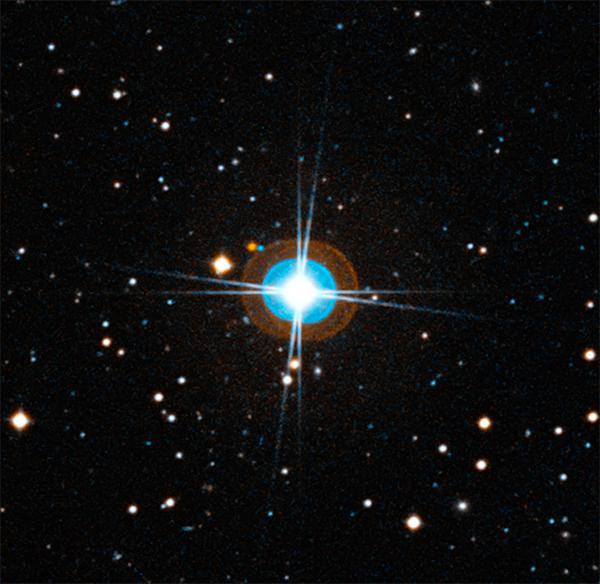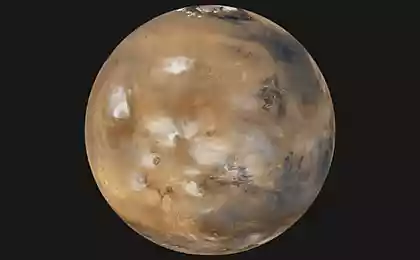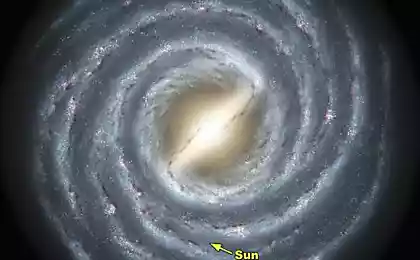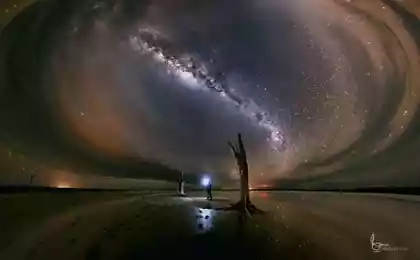605
Solar system surpassed by the number of planets
HD 10180 has a weight of 1, 062 solar, very near the surface temperature, but it is a bit older and metallicity, which should, according to modern ideas, it means the presence of a large planetary system. It seems that the way it is: she found the nine planets - eight against our sun.

In a recent article, the Finnish astronomer Mikko Tuomi re-analyzed information on HARPS planet's star system HD 10180. As you remember, it exoplanet system - the largest known. However, Finnish researchers constructed models turned out that the available data are better explained by nine, not five (or seven), was supposed to planets. Thus, the system of the star, remote from us at 130 St. years, became the new record holder for the number of known planets in general, surpassing even the solar system.
HD 10180 for a time became the leader among planetary systems in the number of known planets. Five of them (HD 10180 C, D, E, F, G), which has been known for certain - it neptunopodobnye planet mass of 12-25 times greater than Earth. The sixth was considered more like Saturn; it is 65 times heavier than our planet.
Photos ESO / Davide De Martin.

Data for the seventh planet had previously been interpreted not too convincing, says the astronomer. Now claims that the seventh, eighth and ninth planet have a weight of 1, 3, 1, 9, 5, 1 earth; in other words, they are all as one "super-Earths." Their rotation periods around the star are respectively 1, 2, 10 and 68 days. Impressive short distance from the local sun: 3, 14 and 50 million km. Obviously, even in the most remote HD 10180 J, with a mass of about five Earth's climate must be extremely severe (Venus in two and a half times farther from the Sun than it is, but Mercury is very close on this parameter). Well, on the surface of the nearest planet HD 10180 B, located more than an order of magnitude closer to its star than Mercury is to ours, may well melt metals.
visual motion video of the seven planets of the nine known
In this solar system, all nine planets are at a very close distance from its star. Even within the ninth planet from the HD 10180, from the Sun than Jupiter. (Fig. ESO / L. Calcada.) Of course, this does not give us a definitive answer to the question of the habitability of the solar system, as we do not know anything about satellites neptunopodobnyh large planets, which in theory could well be in the appropriate zone.
According to the observations of astronomers, for the system of the star HD 10180 observed about Titius - Bode, which is very unusual compared to other exoplanet systems. At the same time there are no pretty standard for the universe planets similar to Jupiter, and it is also unusual.
Finally, the presence of this system of nine full-fledged planets means that the solar system for the first time lost its status as a leader in the indicator. Even supporters of Pluto's planetary status definitely agree that the star HD 10180 planet much more like real than the same Pluto, Charon. In other words, our star system is no longer in its first a planetary population, and that this discovery was made on the basis of re-interpretation of already existing data, suggesting that the other known exoplanet systems can actually be a lot more planets.
science.compulenta.ru/672121/
en.wikipedia.org/wiki/HD_10180
Source:

In a recent article, the Finnish astronomer Mikko Tuomi re-analyzed information on HARPS planet's star system HD 10180. As you remember, it exoplanet system - the largest known. However, Finnish researchers constructed models turned out that the available data are better explained by nine, not five (or seven), was supposed to planets. Thus, the system of the star, remote from us at 130 St. years, became the new record holder for the number of known planets in general, surpassing even the solar system.
HD 10180 for a time became the leader among planetary systems in the number of known planets. Five of them (HD 10180 C, D, E, F, G), which has been known for certain - it neptunopodobnye planet mass of 12-25 times greater than Earth. The sixth was considered more like Saturn; it is 65 times heavier than our planet.
Photos ESO / Davide De Martin.

Data for the seventh planet had previously been interpreted not too convincing, says the astronomer. Now claims that the seventh, eighth and ninth planet have a weight of 1, 3, 1, 9, 5, 1 earth; in other words, they are all as one "super-Earths." Their rotation periods around the star are respectively 1, 2, 10 and 68 days. Impressive short distance from the local sun: 3, 14 and 50 million km. Obviously, even in the most remote HD 10180 J, with a mass of about five Earth's climate must be extremely severe (Venus in two and a half times farther from the Sun than it is, but Mercury is very close on this parameter). Well, on the surface of the nearest planet HD 10180 B, located more than an order of magnitude closer to its star than Mercury is to ours, may well melt metals.
visual motion video of the seven planets of the nine known
In this solar system, all nine planets are at a very close distance from its star. Even within the ninth planet from the HD 10180, from the Sun than Jupiter. (Fig. ESO / L. Calcada.) Of course, this does not give us a definitive answer to the question of the habitability of the solar system, as we do not know anything about satellites neptunopodobnyh large planets, which in theory could well be in the appropriate zone.
According to the observations of astronomers, for the system of the star HD 10180 observed about Titius - Bode, which is very unusual compared to other exoplanet systems. At the same time there are no pretty standard for the universe planets similar to Jupiter, and it is also unusual.
Finally, the presence of this system of nine full-fledged planets means that the solar system for the first time lost its status as a leader in the indicator. Even supporters of Pluto's planetary status definitely agree that the star HD 10180 planet much more like real than the same Pluto, Charon. In other words, our star system is no longer in its first a planetary population, and that this discovery was made on the basis of re-interpretation of already existing data, suggesting that the other known exoplanet systems can actually be a lot more planets.
science.compulenta.ru/672121/
en.wikipedia.org/wiki/HD_10180
Source:























